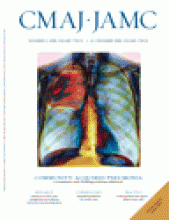- © 2008 Canadian Medical Association
A 34-year-old woman presented with long-standing severe asthma and chronic idiopathic angioedema. We found 2 lesions on her back (Figure 1, Figure 2). The lesions had occurred spontaneously 10 years ago and had grown slightly bigger over that time. They were quite painful, tender and itchy at times. The patient had no history of trauma, surgery or acne. She was seen by a dermatologist for further assessment and continues to attend the outpatient department.
Figure 1: Irregularly shaped, raised pink lesions on the upper back of a 34-year-old woman.
Figure 2: A close-up image shows the irregular margins and smooth, shiny surface of the lesions.
-
Cutaneous sarcoidosis
-
Keloid
-
Dermatofibroma
-
Dermatofibrosarcoma protuberans
-
Hypertrophic scar
What is your diagnosis?
-
Biopsy to confirm your diagnosis
-
Prescription of topical high-potency steroid cream
-
Intralesional steroid injection
-
Surgical excision of the lesion
-
HLA genotyping of the patient
What might be a reasonable next step in treating this patient?
Discussion
The diagnosis is (b) keloid, and the next step in treatment is (c) intralesional steroid injection. The patient was given the intralesional steroid injections, with occlusive dressings and silicone gel. No change was seen in the keloid.
Keloid is a condition characterized by excessive deposition of fibrous tissue. It usually develops after trauma or injury (e.g., earlobe piercing, surgery, acne, chickenpox, surgical incision, burns or vaccination).1 The diagnosis of our patient's condition was straightforward because of the classic nature of the findings: a firm nodule on the upper back that was present for a long time, was relatively unchanged, had a smooth surface and a claw-like, skin-coloured appearance, and was prone to itchiness and tenderness.
The texture of keloids ranges from soft and doughy to rubbery and hard. Keloids vary in colour with age, from erythematous through brownish red to pale pink. Keloidal collagen is arranged haphazardly instead of parallel to the skin surface, as in normal scar formation.2
Keloids grow in a claw-like fashion outward in all directions from the original wound. The extent of growth is grossly out of proportion to the degree of tissue damage. The condition is more prevalent in women than in men. It tends to occur in people aged 10–30 years. Rarely, it can occur in older people (e.g., patients undergoing coronary artery bypass surgery).
People of Polynesian and Chinese backgrounds are most susceptible to keloids, whereas white people are least commonly affected.1 Genetic associations have been identified with several HLA genotypes, including HLA-B14, HLA-B21, HLA-Bw16, HLA-DR5, HLA-DQw3 and blood group A.1
Spontaneous keloid formation is rare. Whether it is truly spontaneous is controversial. The scar tissue may form after an insignificant inflammatory reaction or injury — one that was too trivial for the person to remember. Confirmed instances of spontaneous keloid have been reported in Dubowitz syndrome, Rubenstein–Taybi syndrome and Noonan syndrome.3 Spontaneous keloid has also been reported in siblings3 and in people with allergic disease.4
The differential diagnosis of keloid includes hypertrophic scar, dermatofibroma, dermatofibrosarcoma protuberans and cutaneous sarcoidosis (Table 1). Unlike keloid, hypertrophic scar never occurs spontaneously or extends beyond the margins of the scar. We excluded dermatofibroma because our patient's lesions were neither coloured nor very small or located on the extremities. We also excluded dermatofibrosarcoma protuberans because the lesions did not invade the deeper structures, had not increased considerably in size over time and had not ulcerated. Cutaneous sarcoidosis, known as the great imitator, presents with a variety of appearances, including that of a raised nodular lesion. Its diagnosis requires a biopsy demonstrating non-caseating granuloma. Since the classic characteristics of keloid were present, we did not perform a biopsy, which could have worsened the scar. Biopsy would be a reasonable next step if clinical suspicion or other investigations pointed to another diagnosis (e.g., sarcoidosis).
Table 1.
The optimal treatment for keloid depends on several factors, including previous response to treatment, the patient's age, and the location and size of the affected area. Prevention is better than cure. The “gold standard” treatment is excision followed by careful postoperative care (using occlusive dressings, compression therapy, intralesional corticosteroid injections or radiotherapy). Excision alone should be avoided, because it is associated with high recurrence rates.2 Other treatment options include laser ablation, cryotherapy and drug therapy such as interferons, tamoxifen, verapamil and retinoic acid.1,2
Although many treatment options exist, no treatment alone has proven effective. Most patients experience recurrence following treatment.
Footnotes
-
CMAJ invites submissions to “What is your call?” Clinical details (including images) are presented on the first page along with a multiple-choice question about the diagnosis. The answer and a brief discussion of the condition follow on the second page. We specifically invite submissions illustrating common or important radiographic and electrocardiographic diagnoses of appeal to a general audience. We allow up to 5 references and require authors to obtain consent from the patient for publication of his or her story (form available at www.cmaj.ca/authors/checklist.shtml). Submit manuscripts online at http://mc.manuscriptcentral.com/cmaj.
This article has been peer reviewed.
Competing interests: None declared.













